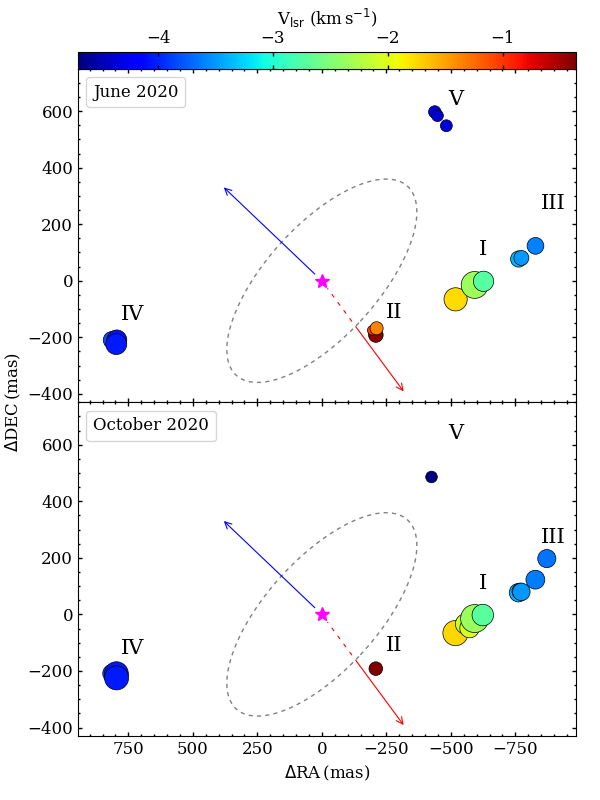
Discovery of recurrent flares of 6.7 GHz methanol maser emission in Cepheus A HW2
by Michał Durjasz, Marian Szymczak, Mateusz Olech and Anna Bartkiewicz (Nicolaus Copernicus University, Poland)

vicinity of the high-mass protostar Cep A HW2. Arrows mark the outflows, reported in
Carrasco-González et al. 2021, dashed line mark the dust disc, reported in
Patel et al. 2005. Magenta star marks the position of a protostar (Curiel et al. 2006).
6.7 GHz methanol maser emission is one of the most important markers of high-mass star formation. It originates relatively close to the protostar (usually within 1000 AU) and is extremely sensitive to variations in the physical properties of the surrounding matter. Since all of the class II methanol masers (including 6.7 GHz transition) are considered to be pumped radiatively, they are often used as markers of protostellar activity, which was also the case in Cep A HW2.
Cepheus A is a high-mass star-forming region located at a trigonometric distance of 700 pc that hosts a cluster of YSOs (young stellar objects). The brightest continuum source in this region is Cep A HW2, a high-mass protostar with a mass of ~10M⊙ that hosts bright 6.7 GHz methanol masers within 1000 AU.
Cep A HW2 was observed on a 6.7 GHz transition by a 32 m antenna located in Piwnice near Toruń (Poland) with a typical cadence of 2 observations per month since June 2009. Single-dish observations revealed low-amplitude red-shifted flares that appeared in 2010, 2015, and 2020; additionally, we detected periods of increased activity of the most blue-shifted feature in 2012 and 2017.
We decided to perform two epochs of the EVN observations to pinpoint cloudlets responsible for these phenomena: 06.2020 and 10.2020. Results revealed that flaring, red-shifted emission originates from the previously reported dust disc's edge. Comparison with older EVN observations revealed the detection of this emission also in 2015, which fully confirmed single-dish observations. Comparison with previous epochs also allowed us to find that blue-shifted emission near the red-shifted flaring cloudlets might also undergo this kind of variability, but blend with much stronger, persistent features on a single-dish profile.
Although we tested several models to find one that matched observational results, none explained observed phenomena flawlessly. Detailed analysis revealed that the most likely cause of the flares is a presence of a companion star that orbits Cep A HW2 with a period of approx. 5.1 years and causes dust to heat up, thus effectively increasing the pumping rate in the vicinity of the red-shifted emission.
Periods of increased activity of the most blue-shifted feature are accompanied by a substantial dip of the brightest maser feature, which occurs with a delay of ~7 days - this value is well within an order of magnitude of the light-crossing time between the cloudlets, which is evidence of a radiative connection between these two.
Published in Durjasz et al 2022 A&A 663, A123